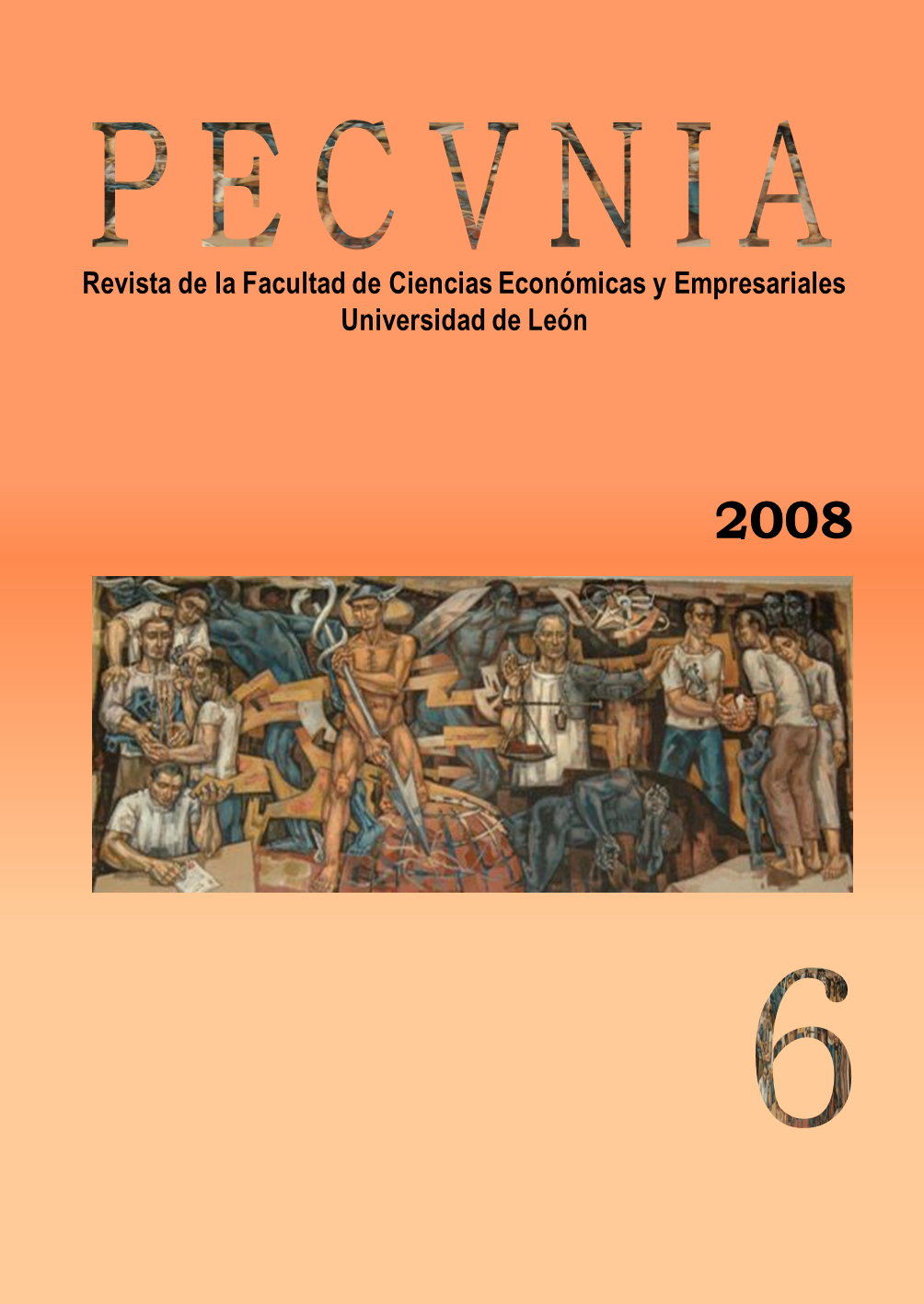El coste de oportunidad como determinante del autoempleo en la Unión Europea (UE 25)
DOI :
https://doi.org/10.18002/pec.v0i6.706Mots-clés :
Creación de empresas, Motivación, Autoempleo | Empleado, Entrepreneurship, Motivation, Self-employment, EmployeeRésumé
Este trabajo pretende introducir en el análisis de la motivación de la actividad emprendedora el potencial efecto negativo del coste de oportunidad asociado a la misma. Para lograr este objetivo se aplicó un análisis de ecuaciones estructurales con la aproximación Partial Least Squares (PLS) sobre una muestra de ciudadanos de la Unión Europea agrupados por países, para el periodo 2004. Los resultados muestran que la motivación emprendedora presenta una estructura interna dual formada por dos componentes independientes, uno relacionado con el atractivo intrínseco del autoempleo y otro relacionado con el atractivo intrínseco del estatus de empleado. Concretamente, los resultados indican una influencia directamente proporcional, sobre la intención emprendedora, de los elementos asociados al atractivo de ser empresario. También se verifica la relación inversamente proporcional de los elementos asociados al atractivo de ser empleado; siendo este efecto desmotivador de menor cuantía que el citado en primer lugar. Desde un punto de vista práctico, se plantea que las políticas de estímulo de la actividad emprendedora deberían tener en cuenta que no únicamente los ciudadanos con actitudes negativas hacia el autoempleo rechazan crear empresas, el atractivo del empleo por cuenta ajena es un determinante adicional significativo.This paper tries to include the potential negative effect of the opportunity cost over the motivation analysis related to the entrepreneurial activity. According to this aim, a Structural Equation Modelling analysis with Partial Least Squares (PLS) approach was performed over a sample of European citizens clustered by country, within the period 2004. The results show that entrepreneurial motivation has a dual internal structure based on two independent components, one connected to the intrinsic attractiveness of self-employment and another one connected to the intrinsic attractiveness of the employee status. Specifically, it is displayed a positive influence of items related to the attractiveness of self-employment on entrepreneurial intentions. Also a negative relationship of items related to attractiveness of the employee status is verified; although, this negative motivation effect is smaller than the first positive one. From a practical point of view, it is proposed that entrepreneurship promotion policies should consider the fact that not only citizens with negative attitudes towards entrepreneurship reject to set up a business; the attractiveness of the employee status is an additional significant determinant
Téléchargements
Références
BAUMOL, W.J. (1993) "Formal Entrepreneurship Theory in Economics: Existence and Bounds", Journal of Business Venturing, vol. 8, nº 2, pp. 197-210.
BAUMOL, W.J. (2004) "Entrepreneurial Cultures and Countercultures", Academy of Management Learning and Education, vol. 3, nº 3, pp. 316-326.
BARCLAY, D.; C. HIGGINS and R. THOMSON (1995) "The Partial Least Squares (PLS) Approach to Causal Modelling: Personal Computer Adoption and Use as Illustration", Technological Studies, vol. 2, nº 2, pp. 285-309.
BROWN, T.E. & J.M. ULJIN (2004) Innovation, Entrepreneurship and Culture: the Integration Between Technology, Progress and Economic Growth. Cheltenham (Reino Unido): Edward Elgar Publishers.
CARMINES, E.G. & R.A. ZELLER (1979) "Reliability and Validity Assessments", Sage University Paper Series on Quantitative Applications in the Social Sciences, vol. 7, nº 07, Sage, Beverly Hills (EE. UU.).
CARROLL, G. & E. MOSAKOWSI (1987) "The Career Dynamics of Self- Employment", Administrative Science Quarterly, vol. 32, nº 4, pp. 570- 589.
CHIN, W.W. (1998) "The Partial Least Squares Approach to Structural Equation Modeling". G.A. MARCOULIDES (ed.) Modern Methods for Business Research. Mahwah: Lawrence Erlbaum Associates, pp. 295-336.
COMISIÓN EUROPEA (2004) Flash Eurobarometer (160): Entrepreneurhip. Bruselas: Comisión Europea.
COPE, J. (2005) "Toward a Dynamic Learning Perspective of Entrepreneurship", Entrepreneurship: Theory & Practice, vol. 29, nº 4, pp. 373–374.
CUERVO, A. (2003) "La creación empresarial: de empresarios y directivos". Enric GENESCÁ, David URBANO, Joan Lluís CAPELLERAS, Carlos GUALLARTE y Joaquín VERGÉS (2003) Creación de Empresas: homenaje al profesor Josá María Veciana Vergés. Barcelona: UAB, pp. 49-74.
ECKHARDT, J. & S. SHANE (2003) "The Importance of Opportunities to Entrepreneurship", Journal of Management, vol. 29, nº 3, pp. 333-349.
FALK, R.F. & N.B. MILLER (1992) A Primer for Soft Modelling. Akron (EE. UU.): University of Akron.
FERNÁNDEZ, E. y B. JUNQUERA (2001) "Factores determinantes en la creación de pequeñas empresas: una revisión de la literatura", Papeles de Economía Española, nº 89/90, pp. 322-342.
FERNÁNDEZ, W. y A. GARCÍA (2004) "Motivaciones y obstáculos en función de la experiencia empresarial del emprendedor", Actas del XIV Congreso de la Asociación Científica de Economía y Dirección de Empresa (ACEDE), 19-21 septiembre, Murcia.
FORNELL, C. y D.F. LARCKER (1981) "Evaluating Structural Equation Models with Unobservable Variables and Measurement Error", Journal of Marketing Research, nº 18, pp. 39-50.
GARTNER, W.B. (1989a) "«Who is an entrepreneur?» is the wrong question", American Journal of Small Business, vol. 13, nº 4, pp. 43–69.
GARTNER, W.B. (1989b) "Some Suggestions for Research on Entrepreneurial Traits and Characteristics", Entrepreneurship: Theory & Practice, vol. 14, nº 1, pp. 27–37.
GARTNER, W.B. (1990) "What Are We Talking About When We Talk About Entrepreneurship?", Journal of Business Venturing, vol. 5, nº 1, pp. 15– 28.
GENESCÁ, E.; D. URBANO, J.L. CAPELLERAS, C. GUALLARTE y J. VERGÉS (2003) Creación de Empresas: homenaje al profesor Josá María Veciana Vergés. Barcelona: UAB.
HAIR JR, J.F.; R.E. ANDERSON, R.L. TATHAM y W.C. BLACK (1999) Análisis multivariante (5ª edición). Madrid: Prentice Hall.
HORNADAY, R.W. (1992) "Thinking About Entrepreneurship: A Fuzzy Set Approach", Journal of Small Business Management, vol. 30, nº 3, pp. 12-23.
HULLAND, J. (1999) "Use of Partial Least Squares (PLS) in Strategic Management Research. A Review of Four Recent Studies", Strategic Management Journal, nº 20, pp. 195-204.
INSTITUTO DE EMPRESA (2004) Global Entrepreneurship Monitor. Informe Ejecutivo (2004) - España. Madrid.
LOW, M.B. & I.C. MCMILLAN (1988) "Entrepreneurship: Past Research and Future Challenges", Journal of Management, vol. 14, nº 1, pp. 110-131.
MCGRATH, R.G. (1999) "Falling Forward: Real Options Reasoning and Entrepreneurial Failure", Academy of Management Review, vol. 24, nº 1, pp. 13–30.
MARTÍNEZ, A. y O. URBINA (1998) "Emprendedores y empresas de alta tecnología: el caso de Aragón", Revista Europea de Dirección y Economía de la Empresa, vol. 7, nº 3, pp. 135-146.
NAFFZIGER, D.W.; J.S. HORNSBY & D.F. KURATKO (1994) "A Proposed Research Model of Entrepreneurial Motivation", Entrepreneurship: Theory and Practice, vol. 18, nº 3, pp. 29-42.
NUNNALLY, J.C. (1978) Psychometric Theory (2nd ed.). New York (EE.UU.): McGraw Hill.
REAL, J.C.; A. LEAL y J.L. ROLDAN (2006) "Aprendizaje organizativo y tecnologías de la información: influencia en el desarrollo de competencias distintivas tecnológicas y resultados empresariales", Revista Europea de Dirección y Economía de la Empresa, vol. 15, nº 4, pp. 9-32.
REINOLDS, P.; N. BOSMA, E. AUTIO, S. HUNT, N. de BONO, I. SERVAIS, P. LÓPEZ-GARCÍA & N. CHIN (2005) "Global Entrepreneurship Monitor: Data Collection, Design and Implementation", Small Business Economy, vol. 24, nº 2, pp. 205-231.
ROBICHAUD, Y.; E. MCGRAW & A. ROGER (2001) "Toward the Development of a Measuring Instrument for Entrepreneurial Motivation", Journal of Developmental Entrepreneurship, vol. Aug (6), nº 2, pp. 189-201.
ROBINSON, P.; D. STIMPSON, J. HUEFNER & H. HUNT (1991) "An Attitude Approach to the Prediction of Entrepreneurship", Entrepreneurship: Theory & Practice, vol. 15, nº 4, pp. 13-31.
RUBIO, E.A.; E. CORDÓN y A.L. AGOTE (1999) "Actitudes hacia la creación de empresas: un modelo explicativo", Revista Europea de Dirección y Economía de la Empresa, vol. 8, nº 3, pp. 37-51.
SHANE, S. & S. VENKATARAMAN (2000) "The Promise of Entrepreneurship as a Field of Research", Academy of Management Review, vol. 25, nº 1, pp. 217–226.
SHANE, S. & S. VENKATARAMAN (2003) A General Theory of Entrepreneurship: The Individual-Opportunity Nexus. Cheltenham (Reino Unido): Edward Elgar Publishers.
SHANE, S.; E.A. LOCKE & C.J. COLLINS (2003) "Entrepreneurial Motivation", Human Resource Management Review, vol. 13, nº 2 (summer), pp. 257-279.
SHAVER, K. & L.R. SCOTT (1991) "Person, Process, Choice: The Psychology of New Venture Creation", Entrepreneurship: Theory & Practice, vol. 16, nº 2, pp. 23–45.
SHAVER, K. & L.R. SCOTT (1995) "The Entrepreneurial Personality Myth", Business and Economic Review, vol. 41, nº 2, pp. 20–23.
STEVENSON, H.H. & J.C. JARILLO (1990) "A Paradigm of Entrepreneurship: Entrepreneurial Management", Strategic Management Journal, vol. 1, nº 1, pp. 17-27.
VECIANA, J.M. (1989) "Características del empresario en España", Papeles de Economía Española, nº 39, pp. 19-36.
VECIANA, J.M. (1999) "Creación de empresas como programa de investigación científica", Revista de Europea de Dirección y Economía de la Empresa, vol. 8, nº 3, pp. 11-33.
Téléchargements
Publiée
Comment citer
Numéro
Rubrique
Licence
(c) Tous droits réservés Luis Miguel Zapico Aldeano, Mariano Nieto Antolín, María Felisa Muñoz Doyague 2008

Ce travail est disponible sous licence Creative Commons Attribution - Pas d’Utilisation Commerciale - Partage dans les Mêmes Conditions 4.0 International.
Los autores que publican en esta revista están de acuerdo con los siguientes términos:- Los autores ceden de forma no exclusiva los derechos de explotación (reproducción, distribución, comunicación pública, transformación) a la Universidad de León, por lo que pueden establecer, por separado, acuerdos adicionales para la distribución no exclusiva de la versión de la obra publicada en la revista (por ejemplo, alojarlo en un repositorio institucional o publicarlo en un libro), con un reconocimiento de su publicación inicial en esta revista.
- Este trabajo se encuentra bajo la Creative Commons Attribution-NonCommercial-ShareAlike 4.0 International License. Puede consultarse desde aquí la versión informativa y el texto legal de la licencia.
- Se permite y se anima a los autores a difundir electrónicamente las versiones pre-print (versión antes de ser evaluada) y/o post-print (versión evaluada y aceptada para su publicación) de sus obras antes de su publicación, ya que favorece su circulación y difusión más temprana y con ello un posible aumento en su citación y alcance entre la comunidad académica.












